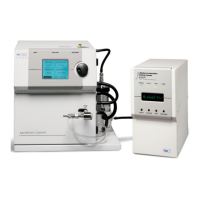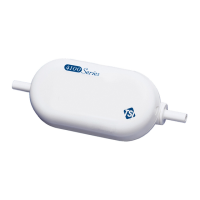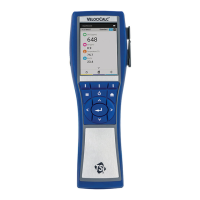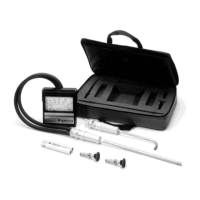7–2 Series 3080 Electrostatic Classifiers
2. Plug all ports on the DMA except for the Monodisperse Flow
port.
3. Connect a pressure gauge or manometer between the
Monodisperse Flow port and a leak-tight valve. The valve should
be closed.
4. Connect the valve to a vacuum source or a vacuum pump
capable of drawing 18 in. Hg vacuum.
5. Turn on the vacuum pump or vacuum system and slowly open
the valve. Allow the vacuum gauge reading to become stable
and then close the valve.
6. Observe the gauge reading. The reading should not change by
more than 0.1 in. Hg in 5 minutes.
7. If the DMA does leak, follow the steps below under “Isolating
Leaks.”
It is much easier to leak-check the Model 3080 Classifier by
breaking the process down into three subsystems: Sheath flow
path, the Bypass flow path, and the aerosol flow path.
To leak-check the Sheath flow path, follow these steps:
1. Plug the EXCESS FLOW port on the Classifier.
2. Connect a pressure gauge or manometer between the SHEATH
FLOW port and a leak-tight valve. The valve should be closed.
3. Connect the valve to a vacuum source or a vacuum pump
capable of drawing 18 in. Hg vacuum.
4. Turn on the vacuum pump or vacuum system and slowly open
the valve. Allow the vacuum gauge reading to become stable
and then close the valve.
5. Observe the gauge reading. The reading should not change by
more than 0.1 in. Hg in 5 minutes.
6. If the Sheath-air plumbing does leak, follow the steps below
under “Isolating Leaks
.”
To leak-check the Bypass flow path, follow these steps:
1. Plug the EXHAUST FLOW port on the Classifier.
2. Connect a pressure gauge or manometer between the BYPASS
FLOW port and a leak-tight valve. The valve should be closed.
3. Connect the valve to a vacuum source or a vacuum pump
capable of drawing 18 in. Hg vacuum.
4. Turn on the vacuum pump or vacuum system and slowly open
the valve. Allow the vacuum gauge reading to become stable
and then close the valve.
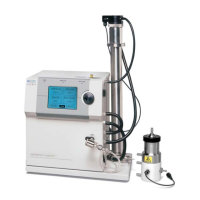
